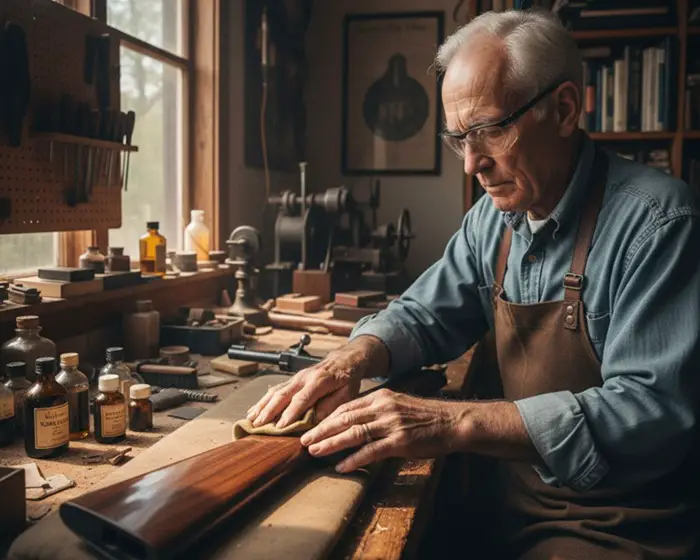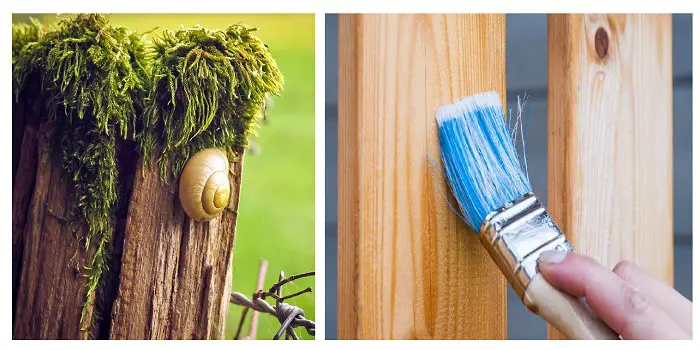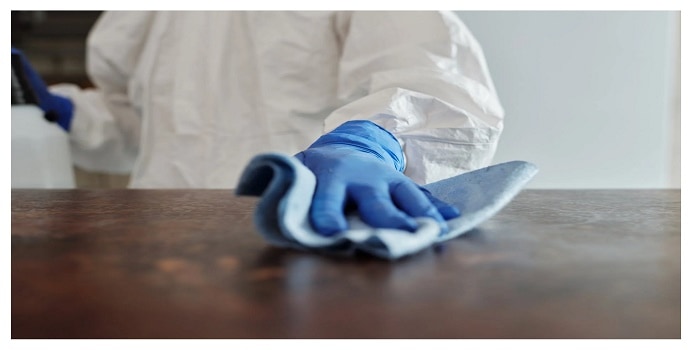
If you’re like most rifle owners, you take great pride in your weapon. You clean and maintain it meticulously, and you store it in a safe place when not in use.
But even the most careful owner can eventually run into problems with their rifle’s wooden stock.
The gun stock’s finish may start to wear off, or the wood may become scratched or dented.
When this happens, it’s time to refinish your gunstock.
But how do you do it the right way?
In this post, we’ll discuss how to refinish your wood stock the right way, preserving its natural beauty and extending its lifespan.
Whether you’re a first-time rifle owner or just want to give your old gun a new look, read on for tips on how to refinish your wooden gunstock like a pro.
Before we jump into the details on gunstock refinishing, let’s understand…
Why are Gun Stocks Made of Wood?
Wooden gunstocks have been used for centuries, and there’s a good reason why they’re still popular today.
Wood is an attractive material that can be stained or finished to achieve the desired look.
It’s also a durable material that can withstand the elements and the wear and tear of everyday use.
When it comes to gunstocks, two main types of wood are commonly used: hardwoods and softwoods.
Hardwoods, such as oak and maple, are denser than softwoods and are, therefore, more resistant to impact damage.
Softwoods, such as pine and fir, are lighter in weight and easier to work with.
Both hardwoods and softwoods make excellent gunstock materials, so it’s really a matter of personal preference.

5 Easy Steps to Refinishing Your Wood Gunstock
Wooden gunstocks can last for generations with the right care.
But even the most well-made stock will eventually need to be refinished.
The good news is that it’s not difficult to refinish your own gunstock at home. With a little time and effort, you can make your rifle look new again.
Here are five easy steps to follow when refinishing your gunstock:
1. Remove the Old Finish
The first step is to remove the existing finish from your gunstock.
This can be done using either a chemical finish remover or mechanical sanding, depending on the type and thickness of the old coating.
Using a Chemical Stripper:
Apply a high-quality methylene chloride-based or citrus-based stripper evenly with a brush, following the manufacturer’s instructions.
Allow it to sit for the recommended dwell time (usually 10–20 minutes) until the old finish softens and bubbles up.
Then, gently scrape off the loosened finish using a plastic or brass scraper to avoid gouging the wood grain.
Always wear chemical-resistant gloves, eye protection, and work in a well-ventilated area or outdoors.
Using Sandpaper:
If you prefer not to use chemicals, you can mechanically remove the finish using sandpaper or an orbital sander.
Start with a 120-grit paper to break through the old finish, being careful not to round over sharp edges or damage checkering.
For checkered areas, use a stiff nylon brush or fine steel wool instead of sandpaper.
Once the old finish has been completely removed, lightly sand the entire stock with 150–180 grit sandpaper to eliminate any remaining stripper residue and smooth out the surface.
Follow the direction of the wood grain at all times to prevent cross-grain scratches.
2. Apply a New Finish
After sanding and preparing the gunstock, the next step is to apply a durable, protective finish.
One of the most popular products for gunstock refinishing is Tru-Oil, manufactured by Birchwood Casey.
After final sanding, wipe the stock thoroughly with a tack cloth or denatured alcohol to remove dust and oils.
Avoid using water, as it can raise the grain. Also, keep in mind that the surface must be completely clean and dry before applying Tru-Oil.
Application Method
- Apply a small amount of Tru-Oil directly with your fingers or a lint-free cloth, rubbing it in thin, even coats along the wood grain.
- A finger application often works best, as the warmth helps the oil penetrate deeper into the wood.
- Each coat should be extremely thin—just enough to lightly wet the surface without forming drips or streaks.
Why Use Tru-Oil for Gun Stock?
Tru-Oil by Birchwood Casey is formulated from a blend of refined linseed oil, mineral spirits, and modified polymers, designed to dry faster and harder than traditional oil finishes.
It produces a hard, water-resistant, and glossy surface that enhances the natural grain and beauty of the wood.
Tru-Oil is favored by gunsmiths because it:
- Combines the depth of an oil finish with the toughness of a varnish.
- It can be layered to achieve the desired sheen—from satin to high gloss.
- It remains clear—won’t cloud, yellow, or crack with age.
- Simple hand-application—no brushes required; dries to a professional finish with minimal effort.
- Suitable for both new stock finishing and refinishing old stocks, and can also be used as a protective sealer for parts like butt plates, recoil pads, and fore-ends.
3. Let the Finish Dry and Cure
After you’ve applied the new finish, it’s important to let it cure properly before using your rifle.
Allow each coat to dry for 8–12 hours at room temperature (ideally 20–25°C with low humidity).
Sometimes it may take 24-48 hours, but consult the manufacturer’s directions for specific curing times.
Between coats, lightly buff the surface with 0000-grade steel wool or 600–800 grit sandpaper to remove dust nibs and improve adhesion. Wipe off any residue before applying the next layer.
4. Building the Finish on Gunstock
- Repeat the process for 5–10 coats, depending on the desired gloss level and depth.
- More coats create a thicker, glossier finish with better moisture resistance.
- For a satin appearance, stop after 3–5 coats and buff the final coat gently with steel wool.
5. Final Curing and Polishing of Wooden Gunstock
- Once the last coat has cured for at least 48–72 hours, you can optionally apply a light coat of gun stock wax or beeswax blend for additional protection and a smooth hand-rubbed luster.
- Buff with a soft cotton cloth to bring out the natural shine.
Pro Tip: When refinishing your rifle’s stock with chemicals, you’ll be working with flammable liquids and fumes, so it’s important to work in a well-ventilated area. Also, make sure that you have a fire extinguisher on hand in case of any accidents.

Other Natural Products to Finish Wooden Gun Stock
If you want your gunstock to look timeless, feel authentic, and stay protected for years, natural finishes are the way to go.
They don’t just sit on the surface—they nourish the wood from within, enhancing its grain and giving it a rich, hand-rubbed glow that synthetic coatings can’t match.
These non-toxic and easy to repair natural finishes also enhance the grain, create a warm, hand-rubbed sheen, and allow the wood to breathe—preventing cracking or peeling over time.
Here are some of the best natural options you can use:
1. Tung Oil
Few finishes can match the beauty and resilience of pure tung oil.
Used for centuries, it penetrates deep into the wood, hardening from within to create a warm, durable, and water-resistant surface.
Applying tung oil is simple—rub a thin coat with a clean cloth, let it soak for about 15 minutes, and wipe away the excess.
Reapply occasionally to refresh the sheen and protection. The more coats you apply, the deeper and richer the finish becomes.
2. Linseed Oil
Boiled linseed oil remains a classic choice among craftsmen for good reason.
It enhances the natural figure of the wood, giving it a smooth satin glow while forming a resilient barrier against moisture.
Apply a thin coat of linseed oil, let it absorb for 15 minutes, and wipe off any extra.
With regular touch-ups, linseed oil keeps your gunstock looking elegant and well cared for, year after year.
3. Beeswax
For those who appreciate a soft, traditional sheen, beeswax offers a natural, breathable layer of protection.
It’s easy to apply—simply melt a small amount, rub it on evenly, and buff once it cools.
Beeswax repels moisture, prevents dullness, and leaves behind a silky feel that enhances handling comfort.
A quick reapplication now and then keeps the wood looking alive and well.
4. Carnauba Wax
If you prefer a tougher, high-gloss finish, carnauba wax is your go-to.
Known as the “queen of waxes,” it forms a hard, glassy surface that resists water, scratches, and handling wear.
Just melt, apply, let it set, and buff to a mirror-like polish. It’s an excellent upgrade for those who want both natural beauty and lasting durability.
5. Shellac
For a rich, classic finish that truly stands out, shellac delivers unmatched depth and shine.
Made from natural lac resin, it dries quickly, seals the wood, and brings out stunning clarity in the grain.
Wipe on a thin coat, allow it to dry for about 15 minutes, and buff lightly.
Shellac can be layered for extra gloss and protection, making your gunstock look refined and well-crafted.
How to Repair Scratches on Your Old Gun Stock?
Over time, even a well-cared-for gunstock can develop scratches from handling or storage.
Fortunately, most marks can be repaired easily with a few simple techniques, depending on their depth.
1. For Light or Surface Scratches
If the scratch is shallow and hasn’t penetrated the finish, you can often restore the surface without sanding.
Polish or Wax: Apply a small amount of beeswax, furniture polish, or carnauba wax directly over the scratch using a soft cloth.
Buff Gently: Rub along the wood grain until the mark blends in with the surrounding finish.
This not only fills minor scratches but also restores shine and adds a layer of protection.
2. For Medium Scratches
If the scratch goes through the finish but not deep into the wood, you’ll need a slightly stronger approach.
Steam Out the Dent: Dampen a clean cotton cloth, place it over the scratch, and briefly press with a hot iron (set to medium heat). The steam helps the compressed wood fibers expand and minimize the mark.
Light Sanding: Once dry, lightly sand the area with 600–800 grit sandpaper to smooth it out, then wipe clean.
Reapply Finish: Restore color and sheen using a few thin coats of tung oil, linseed oil, or shellac, buffing gently between coats.
3. For Deep Scratches or Gouges
If the scratch is deep enough to expose bare wood:
Fill the Damage: Use a matching wood filler or epoxy putty to fill the gouge. Apply with a putty knife, pressing firmly to remove air pockets.
Sand Smooth: After the filler has cured, sand the repaired area flush with 320–400 grit sandpaper.
Blend and Refinish: Apply a stain (if needed) to match the original color, then finish with your choice of tung oil, linseed oil, carnauba wax, or shellac. Apply multiple thin coats for a seamless look.

What Not to Use on Your Wooden Rifle Stock? (Mistakes to Avoid)
When maintaining or refinishing your wooden gunstock, it’s just as important to know what to avoid as it is to know what to use.
The wrong products can damage the finish, weaken the wood, or ruin the natural look you’ve worked to preserve.
1. Harsh Solvents and Paint Strippers
Avoid using acetone, lacquer thinner, or aggressive paint removers not meant for fine woodwork.
These chemicals can strip natural oils, soften glue joints, and discolor the grain, leaving the wood brittle and uneven.
2. Silicone-Based Polishes
Household furniture sprays containing silicone (like some commercial polishes) should never be used on gunstocks.
Silicone residue seeps into the pores of the wood, making future refinishing nearly impossible and often causing a blotchy finish.
3. Household Oils or Grease
Products like motor oil, mineral oil, or cooking oil may make the wood look shiny at first but will eventually attract dust, turn sticky, and darken the stock.
They don’t harden or protect the surface the way proper wood oils (like tung or linseed oil) do.
4. Heavy Varnishes or Polyurethane Paints
While durable, thick synthetic coatings like polyurethane form a plastic-like shell that prevents the wood from breathing.
Over time, they can crack, peel, or trap moisture, leading to hidden rot and damage under the surface.
5. Excessive Water or Steam
Water may raise the grain slightly for sanding, but soaking or cleaning your stock with water-based products can warp the wood and ruin the finish.
Always use minimal moisture and dry immediately after any cleaning or steaming.
6. Abrasive Cleaners or Rough Sandpaper
Coarse sandpaper (below 120 grit) or abrasive scrubbing pads can easily cut through fine details, rounding off edges and checkering.
Always start with fine grit and work carefully along the grain.
7. Water-Based Finishes
Water-based finishes don’t penetrate as deeply into the wood fibers as oils like tung or linseed oil, so they lack that rich, hand-rubbed glow traditional gunstocks are known for.
Also, if you ever decide to switch to an oil finish later, removing a water-based topcoat can be tricky.
In short, water-based finishes are fine for a clean, modern look and easy maintenance—but for a traditional, warm, and time-tested gunstock finish, natural oils like Tru-Oil, tung oil, or boiled linseed oil still offer the best depth, feel, and long-term resilience.
Finishing Touches: Creative Ideas for Customizing Your Wooden Stock
Once the finish is cured, the fun part begins — personalizing the stock so it’s uniquely yours.
Below are practical, creative, and durable options with quick how-to notes and cautions so your custom work looks professional.
1. Laser Engraving — precise and permanent
Ideal for initials, logos, family crests, or fine artwork. Laser engraving cuts into the finish/wood for crisp detail.
- How: Send a high-resolution vector or black-and-white image to a laser shop; they’ll advise on depth and contrast.
- Tip: Test on scrap wood to pick the right power setting; darker woods show shallower engraving better.
- Caution: After engraving, reseal the area with a thin coat of your finish (Tru-Oil or shellac) to protect exposed fibers.
2. Inlays — depth and luxury
Use wood, mother-of-pearl, metal, or resin inlays for a high-end look. Inlays add color and texture without changing the stock’s profile.
- How: Rout a shallow recess to match the inlay piece, glue with thin CA glue or epoxy, then sand flush and finish.
- Tip: Keep inlay edges small and rounded to avoid stress risers near checkering or screws.
3. Decals & Transfers — fast and flexible
Water-slide decals or heat transfers are perfect for complex graphics or photographic detail.
- How: Apply to a fully cured finish, seal with several thin coats of finish, and buff between coats.
- Tip: Use clear, high-quality decal film and press out bubbles with a soft squeegee.
- Caution: Decals are decorative — for long-term durability, encapsulate under multiple finish coats.
4. Staining & Toning — change the mood
Tint the wood for a bold or subtle color shift using dyes or pigmented stains before final finishing.
- How: Apply dye stains (alcohol or aniline) for vivid, penetrating color; wipe grain filler or oil after staining if needed, then topcoat.
- Tip: Work from light to dark; you can always deepen color but can’t easily lighten it. Test on scrap.
5. Painted Accents — modern or tactical
Use masking and fine brushes for stripes, panels, or subdued camo. Acrylics or lacquer paints work well when sealed properly.
- How: Mask carefully, use thin coats, and finish with clear coats for protection.
- Caution: Avoid large painted surfaces where grip and feel are important — paint can crack under flex.
6. Carving & Relief Work — handcrafted character
Low-relief carving or gentle stippling adds tactile detail and a custom silhouette.
- How: Use sharp chisels or a rotary tool for controlled cuts; sand and seal carved areas thoroughly.
- Tip: Keep carvings shallow near screw beds and checkering to preserve strength.
Final finishing and protection
After customization, encapsulate your work with multiple thin coats of your chosen finish (oil, shellac, or a wipe-on varnish).
Sand lightly between coats for a seamless integration. Finish with a soft wax polish for handling comfort and extra water resistance.
FAQs
Can you replace a gunstock?
Yes, you can replace a gunstock of Remington, Winchester, Savage, and Ruger, but it’s usually not necessary.
If your stock is damaged or worn, you can refinish it yourself to make it look new again.
Does REM oil damage wood stock?
No, REM oil will not damage wood stocks. In fact, it can actually help to protect the wood and keep it looking new.
REM oil is a great option for refinishing your wood gun stock because it’s easy to apply and it dries quickly.
Plus, it’s a non-toxic, environmentally friendly option that won’t harm the wood.
Can you refinish a laminate gunstock?
Yes, you can refinish a laminate gunstock. However, it’s important to note that laminate stocks are more difficult to refinish than wood stocks.
If you’re not confident in your ability to refinish a laminate stock, we recommend taking it to a professional.
Can you apply stain or paint to a wooden gunstock?
Yes, you can apply stain or paint to a wooden gunstock to change its color or create a custom look.
Stains penetrate the wood to enhance the grain, while paints sit on the surface to provide solid color and design options. Always finish with a protective topcoat, such as tung oil, shellac, or varnish, to seal and preserve your work.
For synthetic gunstocks, painting is easier and more forgiving since the material doesn’t absorb oils like wood. However, staining is generally not effective on synthetic stocks because they lack natural grain.
Final Thoughts
Refinishing your wooden gunstock is a great way to extend its lifespan and keep it looking new.
However, when doing so, you’ll need to sand the stock down to bare wood. This will remove any existing finishes and give you a blank canvas to work with.
With a little time and effort, you can easily refinish your wood gun stock and make it look new again. And with these creative ideas for customizing your stock, you can make it truly one-of-a-kind.

Hi, I am Mark Garner a professional carpenter, woodworker, and DIY painter. I live in the small city of Peoria, Arizona as a semi-retired woodworker. I have started this blog with a simple motive to help you with my wood experience in this sector. If you like to know more about what I love doing and how it all got started, you can check more about me here.




